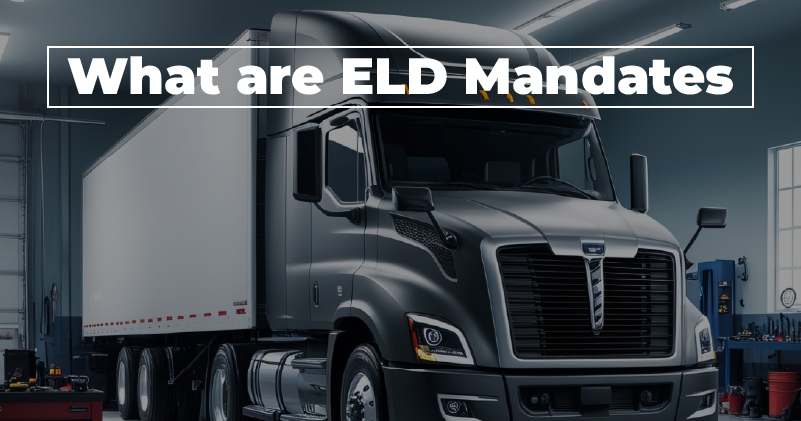
The trucking industry has undergone significant changes in recent years, and one of the most impactful regulations has been the introduction of the ELD (Electronic Logging Device) mandates. These mandates require commercial motor vehicles (CMVs) to be equipped with certified ELDs that track and record hours of service (HOS) data. By digitally monitoring HOS, ELDs ensure that drivers comply with federal safety regulations, reduce paperwork, and promote road safety.
The US ELD Mandate officially came into effect on December 18, 2017. This marked a turning point for how drivers and carriers record and manage their HOS, transitioning from paper logs to an electronic system. Since then, the mandate has aimed to combat driver fatigue and improve road safety, which are crucial issues in the commercial transportation sector.
In this blog, we’ll dive deeper into what are ELD mandates, who it affects, and the numerous benefits it brings to the US trucking industry.
What Is the US ELD Mandate?
The US ELD mandate was enacted by the Federal Motor Carrier Safety Administration (FMCSA) and applies to most commercial motor vehicles engaged in interstate or intrastate operations. According to the rule, CMVs that were previously required to keep paper logbooks must now adopt ELD technology.
Who Must Comply?
The mandate affects a wide range of carriers and drivers, but there are a few exemptions:
- Short-haul drivers: Those who operate within a 150-air-mile radius and return to their home terminal within a 14-hour workday are not required to use an ELD.
- Pre-2000 model vehicles: Older CMVs built before 2000 are exempt because of the technical limitations in retrofitting these vehicles with modern ELD systems.
What Is Required for Compliance?
To comply with the mandate, ELDs must be certified by a third-party and meet technical standards set by the FMCSA. Carriers must retain ELD data for at least six months and be able to present it to enforcement officials upon request. ELDs are expected to automatically record key details such as engine status, vehicle motion, and driver activity, ensuring the integrity of the HOS logs.
One of the major goals of the US ELD mandate is to improve accuracy in tracking HOS, ultimately enhancing safety for both drivers and other road users. By using certified ELDs, drivers and fleet managers can significantly reduce errors or intentional logbook violations that could lead to non-compliance.
 Benefits of the ELD Mandate
Benefits of the ELD Mandate
The ELD mandate has sparked debate in the industry, but the benefits it offers far outweigh the initial setup costs. Below are some of the key advantages that ELDs bring to the trucking and logistics sector:
- Improved Road Safety
Driver fatigue is one of the leading causes of accidents on highways. By ensuring that drivers stick to the hours of service regulations, ELDs reduce the risk of fatigue-related crashes. ELDs monitor driving hours accurately, ensuring that drivers take mandatory breaks, and that long-haul operations comply with federal rules. This increases safety for everyone on the road.
- Enhanced Accuracy and Compliance
Unlike traditional paper logbooks, ELDs offer an automated and highly accurate way to record driving hours. They reduce the chances of human error and intentional falsification, which can occur when paper logs are used. This level of transparency ensures that both drivers and companies are compliant with the FMCSA’s HOS regulations.
- Reduced Administrative Burden
Before ELDs, drivers and carriers had to manage vast amounts of paperwork related to HOS tracking. With ELDs in place, the process of logging hours is fully automated, significantly reducing the time spent on paperwork. For fleet managers, ELDs streamline the auditing process, providing easy access to historical data that is securely stored for regulatory purposes.
- Improved Fleet Management
ELDs provide a wealth of data that can be used by fleet managers to optimize operations. With real-time access to vehicle and driver data, managers can:
- Track vehicle location and driver performance
- Plan better routes and schedules
- Identify inefficiencies and address them
By leveraging these insights, companies can reduce fuel consumption, limit idle time, and increase overall operational efficiency.
- Reduced Risk of Fines and Penalties
Non-compliance with HOS regulations can lead to hefty fines and penalties for carriers. The ELD mandate minimizes this risk by ensuring that hours are recorded accurately and consistently. Enforcement officers can easily access digital logs during roadside inspections, ensuring that drivers remain compliant with regulations.
- Data Transparency and Legal Protection
In the event of an accident or legal dispute, ELDs provide reliable, tamper-proof data that can be used as evidence. This can be especially important for protecting a company’s interests, as it helps in demonstrating that a driver was compliant with HOS regulations at the time of an incident.
- Better Driver Performance and Satisfaction
While some drivers were initially hesitant about the switch to ELDs, many have reported that the devices have actually improved their overall work experience. By automating the logging process, drivers no longer have to worry about tedious paperwork. Additionally, accurate record-keeping ensures that drivers are compensated fairly for their time, especially when it comes to overtime and rest periods.
- Long-Term Cost Savings
Though implementing ELDs comes with an initial cost, the long-term savings are substantial. Fleet managers can save on administrative expenses, reduce the risk of non-compliance fines, optimize fuel usage, and make more informed decisions about vehicle maintenance and routing, all of which lead to significant cost reductions over time.
The Future of the US ELD Mandate
The ELD mandate continues to evolve, with ongoing updates to ensure the technology remains secure and efficient. As the FMCSA and other stakeholders gather more data, there may be adjustments to the regulations to further improve safety and operational efficiency within the trucking industry.
It’s important for carriers and fleet managers to stay informed about any changes and ensure their systems are up to date with the latest ELD compliance standards. Failing to do so could result in penalties and decreased operational efficiency.
Conclusion: How TMS-Digital Can Help
Implementing ELDs is just one piece of the puzzle for managing a modern, compliant, and efficient fleet. To fully optimize your fleet management, integrating ELD data with a comprehensive Transportation Management System (TMS) is essential.
TMS-Digital, one of the leading TMS solutions providers in the US, offers a platform that integrates seamlessly with your ELD data. It helps fleet managers monitor compliance, improve route efficiency, reduce fuel costs, and ensure driver satisfaction—all while maintaining full adherence to HOS regulations. By leveraging the power of ELD and TMS systems together, your company can reduce costs, increase productivity, and stay compliant with ease.
If you’re ready to elevate your fleet management with advanced digital tools, look no further than TMS-Digital. Get in touch with our team today to learn more about how our platform can drive your business forward.









